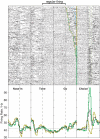Functional properties of striatal fast-spiking interneurons
- PMID: 21743805
- PMCID: PMC3121016
- DOI: 10.3389/fnsys.2011.00045
Functional properties of striatal fast-spiking interneurons
Abstract
Striatal fast-spiking interneurons (FSIs) have a major influence over behavioral output, and a deficit in these cells has been observed in dystonia and Tourette syndrome. FSIs receive cortical input, are coupled together by gap junctions, and make perisomatic GABAergic synapses onto many nearby projection neurons. Despite being critical components of striatal microcircuits, until recently little was known about FSI activity in behaving animals. Striatal FSIs are near-continuously active in awake rodents, but even neighboring FSIs show uncorrelated activity most of the time. A coordinated "pulse" of increased FSI firing occurs throughout striatum when rats initiate one chosen action while suppressing a highly trained alternative. This pulse coincides with a drop in globus pallidus population activity, suggesting that pallidostriatal disinhibition may have a important role in timing or coordinating action execution. In addition to changes in firing rate, FSIs show behavior-linked modulation of spike timing. The variability of inter-spike intervals decreases markedly following instruction cues, and FSIs also participate in fast striatal oscillations that are linked to rewarding events and dopaminergic drugs. These studies have revealed novel and unexpected properties of FSIs, that should help inform new models of striatal information processing in both normal and aberrant conditions.
Keywords: GABA; amphetamine; antipsychotic; basal ganglia; dopamine; gamma oscillations; interneuron; striatum.
Figures

References
-
- Bennett B. D., Wilson C. J. (2003). “TANs, PANs and STANs,” in The Basal Ganglia VI, eds Graybiel A. M., DeLong M. R., Kitai S. T. (New York: Plenum Press; ), 225–236
-
- Berke J. D. (2005). “Participation of striatal neurons in large-scale oscillatory networks,” in The Basal Ganglia VIII, eds Bolam J. P., Ingham C. A., Magill P. J. (New York: Springer; ), 25–35
LinkOut - more resources
Full Text Sources
Miscellaneous

